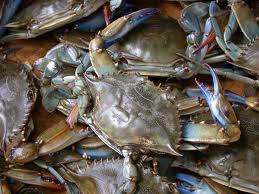Blue crab
Callinectes sapidus
|
|
http://upload.wikimedia.org/wikipedia/commons/3/3e/Blue_crab_on_market_in_Piraeus_-_Callinectes_sapidus_Rathbun_20020819-317.jpg
- Distinguishing characteristics: Blue crabs have greenish color with blue highlights. They have strong claws and their back appendages are adapted for swimming. They have three pairs of walking legs. Males (jimmies) have a pointed apron that resembles the Washington monument while females’ (sooks) aprons are broader and resemble the Capital building.
In the Wild
- Habitat: The blue crab is a bottom dweller that lives in all parts of the Bay at various life stages.
- Diet: Blue crabs are very much opportunistic feeders meaning they will eat what they find including clams, oysters, dead fish, bristle worms, detritus and even other blue crabs.
- Predators: Blue crab predators include croakers, birds such as herons, striped bass, turtles and humans.
- Size: Blue crabs can get up to 9 inches long from point-to-point.
- Breeding: Blue crabs mate in the middle Bay from May-October. Females molt before mating and as a result the male will cradle the female after mating until her shell hardens.
- Life Span: Blue crabs do not typically live longer than three years.
In the Aquatics Lab
- Diet: We feed the crabs pieces of squid.
- Size: The blue crabs here at Booker T. Washington range in size from about a 1.5 inches across to about 6 inches across.
- Quantity: Booker T is home to 8 blue crabs.
Other information
- Virginia Regulations: Blue crabs must be 5 inches across to be kept by a recreational crabber.
- Commercial Uses: Blue crabs are caught and sold as food.
